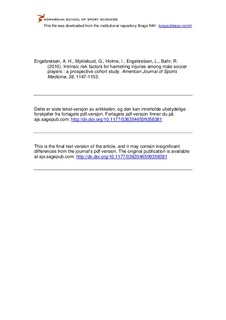| dc.description.abstract | Background: Strain injuries of the posterior thigh are common in soccer. It seems that previous injury and age are important risk factors, but the literature is limited. This study was conducted to see if we could identify intrinsic risk factors for hamstring injuries among male soccer players. Hypothesis: We hypothesized that previous hamstring injuries, reduced function scores, abnormalities on a clinical examination, high maximum sprint speed, poor hamstring strength, or low hamstring/quadriceps ratio can predict increased risk of new hamstring injuries.
Study Design: Cohort study; Level of evidence, 2. Methods: A total of 508 players representing 31 amateur teams were tested during the 2004 preseason for potential risk factors
for hamstring injury through a questionnaire on previous injury and function score (Hamstring Outcome Score [HaOS]), a clinical examination of the hamstring, and specific hamstring relevant tests. Generalized estimating equations were used in univariate
analyses to identify candidate risk factors, and factors with a P value of\.10 were then examined in a multivariate model.
Results: During the soccer season, 76 hamstring injuries, affecting 65 legs (61 players), were registered. Univariate analyses revealed previous acute hamstring injury (yes/no) (odds ratio [OR], 2.62; 95% confidence interval [CI], 1.54-4.45), HaOS function score with all subscores except ‘‘Soreness’’ (OR for a 10-point difference in total score, 1.29; 95% CI, 1.08-1.54), age (OR, 1.25;
95% CI, 0.96-1.63), and player position (P 5 .09) as candidate predictors of high injury risk. In a multivariate analysis, the most important risk factor for injuries to the hamstring was previous acute hamstring injury (yes/no) (adjusted OR, 2.19; 95% CI, 1.19- 4.03; P 5 .01).
Conclusion: In a multivariate analysis, previous acute hamstring injury was found to be a significant risk factor for new hamstring injuries. Previously injured players have more than twice as high a risk of sustaining a new hamstring injury. | en_US |
